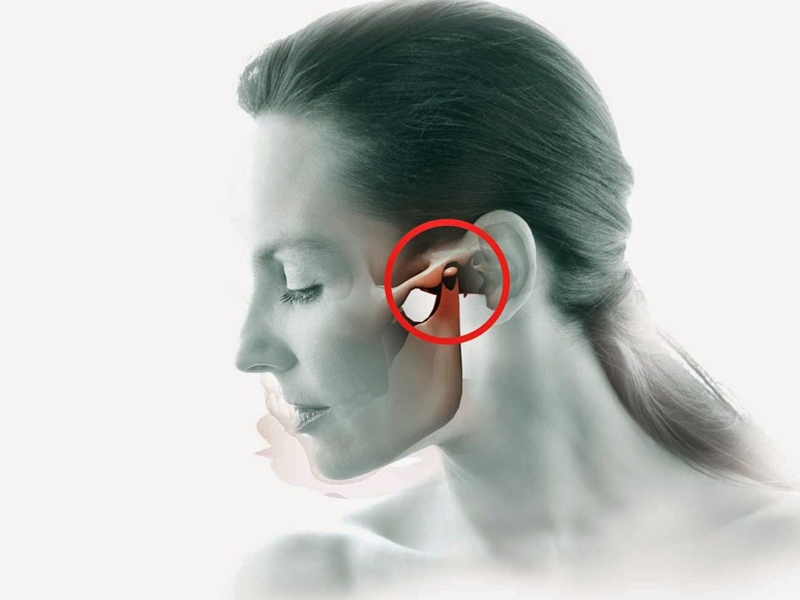Unstable Chewing System
Chewing System (HTN) is a whole, a functional unit including: teeth and periodontal, jaw bone, temporomandibular joint, muscles involved in the movement of the lower jaw (jaw) the tongue, the salivary gland, the nervous-muscle and blood vessels that nourish, regulate and maintain the function of the organs.
![]() Arthritis and temporomandibular joint
Arthritis and temporomandibular joint
![]() The wisdom teeth in the right upper jaw cause pain
The wisdom teeth in the right upper jaw cause pain

Chewing system and chewing disorders
![]() In humans, HTN is a multifunctional system. Chewing, sucking, biting, chewing, and swallowing are usually mentioned first. The "tools" and "weapons" functions still exist, but do not play a decisive role and no longer play the role of a meaningful life function. HTN, in addition to the original function of chewing, also has important functions in various human activities such as speech function, communication function (including aesthetic function) and expression ... to express verbal thinking, expressing emotions as well as other relationships with the natural, social and human communities.
In humans, HTN is a multifunctional system. Chewing, sucking, biting, chewing, and swallowing are usually mentioned first. The "tools" and "weapons" functions still exist, but do not play a decisive role and no longer play the role of a meaningful life function. HTN, in addition to the original function of chewing, also has important functions in various human activities such as speech function, communication function (including aesthetic function) and expression ... to express verbal thinking, expressing emotions as well as other relationships with the natural, social and human communities.
![]() Functional function of HTN occurs with the close coordination between teeth of two jaws, jaw muscles and temporomandibular joints, reflecting the state of biological unity, expressed by the response of the effect Most of the structure and function in all components to ensure the maintenance of comfort and health for the HTN. Physiological adjustments for the purpose of regeneration and repair such as bone renewal, tooth movement, functional status of the jaw muscles, temporomandibular joints ... occur not to exceed the limit of ability adaptability.
Functional function of HTN occurs with the close coordination between teeth of two jaws, jaw muscles and temporomandibular joints, reflecting the state of biological unity, expressed by the response of the effect Most of the structure and function in all components to ensure the maintenance of comfort and health for the HTN. Physiological adjustments for the purpose of regeneration and repair such as bone renewal, tooth movement, functional status of the jaw muscles, temporomandibular joints ... occur not to exceed the limit of ability adaptability.
![]() The relationship between chemistry components depends not only on the biological function but also on the morphological features, community food habits and individual choreography patterns. And this relationship can not be separated from relationships with the body, including physical and mental, emotional and social activities and conditions, which are different degrees of interaction and interaction. The great difference depends on the ability to adapt, feel and sense threshold ... between this individual and the other person. Body principle is a unified and unified body that is richly represented in human activity and interactions between the chewing system and other organ systems, most notably with expressions of feelings, emotions, wills ...
The relationship between chemistry components depends not only on the biological function but also on the morphological features, community food habits and individual choreography patterns. And this relationship can not be separated from relationships with the body, including physical and mental, emotional and social activities and conditions, which are different degrees of interaction and interaction. The great difference depends on the ability to adapt, feel and sense threshold ... between this individual and the other person. Body principle is a unified and unified body that is richly represented in human activity and interactions between the chewing system and other organ systems, most notably with expressions of feelings, emotions, wills ...
![]() This causes the abnormal physiological and pathological problems of the TBN to become extremely complex, as it relates to factors unrelated to chewing and non-physical factors. Therefore, many disorders in HTN are multifactorial and are considered psychiatric disorders. The response and adaptability of each individual to the imperfect state (very common) of the Angola is very different.
This causes the abnormal physiological and pathological problems of the TBN to become extremely complex, as it relates to factors unrelated to chewing and non-physical factors. Therefore, many disorders in HTN are multifactorial and are considered psychiatric disorders. The response and adaptability of each individual to the imperfect state (very common) of the Angola is very different.
![]() When HTN's ability to adapt exceeds levels due to acute or chronic injury, resulting in disparity or imbalance in the relationship between structural components, it is called HTN dysfunction.
When HTN's ability to adapt exceeds levels due to acute or chronic injury, resulting in disparity or imbalance in the relationship between structural components, it is called HTN dysfunction.
![]() HTN dysfunction can vary widely from transient manifestations, to poorly understood functional impairments, and to hindering the quality of life of the individual.
HTN dysfunction can vary widely from transient manifestations, to poorly understood functional impairments, and to hindering the quality of life of the individual.

Jaw-jaw disorders are increasingly common
![]() This is an increasingly important issue in most countries around the world. Over the past two decades, studies have shown that temporomandibular disorders (RLTDH) are high in the general population. In the United States (1993), 22% of the population have at least one of the symptoms of COPD. Canada (1995) is 30%. Sweden (1991) was 19%. Japan (1996) was 46%. Saudi Arabia (1995) was 30% with mild disturbances and 6% with severe temporomandibular joint disease.
This is an increasingly important issue in most countries around the world. Over the past two decades, studies have shown that temporomandibular disorders (RLTDH) are high in the general population. In the United States (1993), 22% of the population have at least one of the symptoms of COPD. Canada (1995) is 30%. Sweden (1991) was 19%. Japan (1996) was 46%. Saudi Arabia (1995) was 30% with mild disturbances and 6% with severe temporomandibular joint disease.
![]() In Vietnam, the study of Vo Dac Tuyen (1991) in 40 patients who came to the Department of Odonto-Dentistry, University of Medicine and Pharmacy showed the highest rate 75% of myopathy, 50% of myalgia, 5% of myalgia, 12.5% of tinnitus, tinnitus with 2.5% of hearing loss and 10% of myocardial dysfunction. The research of Ho Thi Ngoc Linh (2003) on 1,020 workers of Phong Phu Textile Company showed that the number of people who exhibited the disease was very high, up to 60.5%; The most common signs were rattle, 39.1%, headache and neck pain - 9.4%.
In Vietnam, the study of Vo Dac Tuyen (1991) in 40 patients who came to the Department of Odonto-Dentistry, University of Medicine and Pharmacy showed the highest rate 75% of myopathy, 50% of myalgia, 5% of myalgia, 12.5% of tinnitus, tinnitus with 2.5% of hearing loss and 10% of myocardial dysfunction. The research of Ho Thi Ngoc Linh (2003) on 1,020 workers of Phong Phu Textile Company showed that the number of people who exhibited the disease was very high, up to 60.5%; The most common signs were rattle, 39.1%, headache and neck pain - 9.4%.
![]() Malignant temporomandibular disorders?
Malignant temporomandibular disorders?
![]() Temporal-jaw disorders are a general term for disorders related to chewing muscles, to the temporal-jaw joint or both.
Temporal-jaw disorders are a general term for disorders related to chewing muscles, to the temporal-jaw joint or both.
![]() Rheumatism includes many clinical conditions associated with the system of chewing muscles and temporomandibular joints. RLTDH is a subtype of the musculoskeletal-muscle disorders of the body.
Rheumatism includes many clinical conditions associated with the system of chewing muscles and temporomandibular joints. RLTDH is a subtype of the musculoskeletal-muscle disorders of the body.
![]() Recent studies show that DHT is a set of disorders of the chewing system with many common features, the most common common symptom is pain, usually pain in the chewing muscles, in the ear or in the temporomandibular joint, or both. Pain usually increases with eating, chewing or jaw movement. Patients may have headaches, earaches, jaw pain and facial pain. Other symptoms may include limitation of movement of the jaw, vocalisation of the temporo-jaw joint when opening or closing the mouth ...
Recent studies show that DHT is a set of disorders of the chewing system with many common features, the most common common symptom is pain, usually pain in the chewing muscles, in the ear or in the temporomandibular joint, or both. Pain usually increases with eating, chewing or jaw movement. Patients may have headaches, earaches, jaw pain and facial pain. Other symptoms may include limitation of movement of the jaw, vocalisation of the temporo-jaw joint when opening or closing the mouth ...
![]() In many cases, these disorders can be mild, transient and spontaneous without treatment. In other cases, these manifestations become worse if not properly treated.
In many cases, these disorders can be mild, transient and spontaneous without treatment. In other cases, these manifestations become worse if not properly treated.
NHAN TAM DENTAL CLINIC
Address: 801-809, 3/2 Street, Ward 7, District 10, HCMC
Hotline: 1900 56 5678
Thank you for visiting www.nhakhoanhantam.com

FIVE GOLDEN ELEMENTS MADE THE NHAN TAM DENTAL CLINIC BRAND
COME WITH US TO GET YOUR HEALTHY TEETH
















